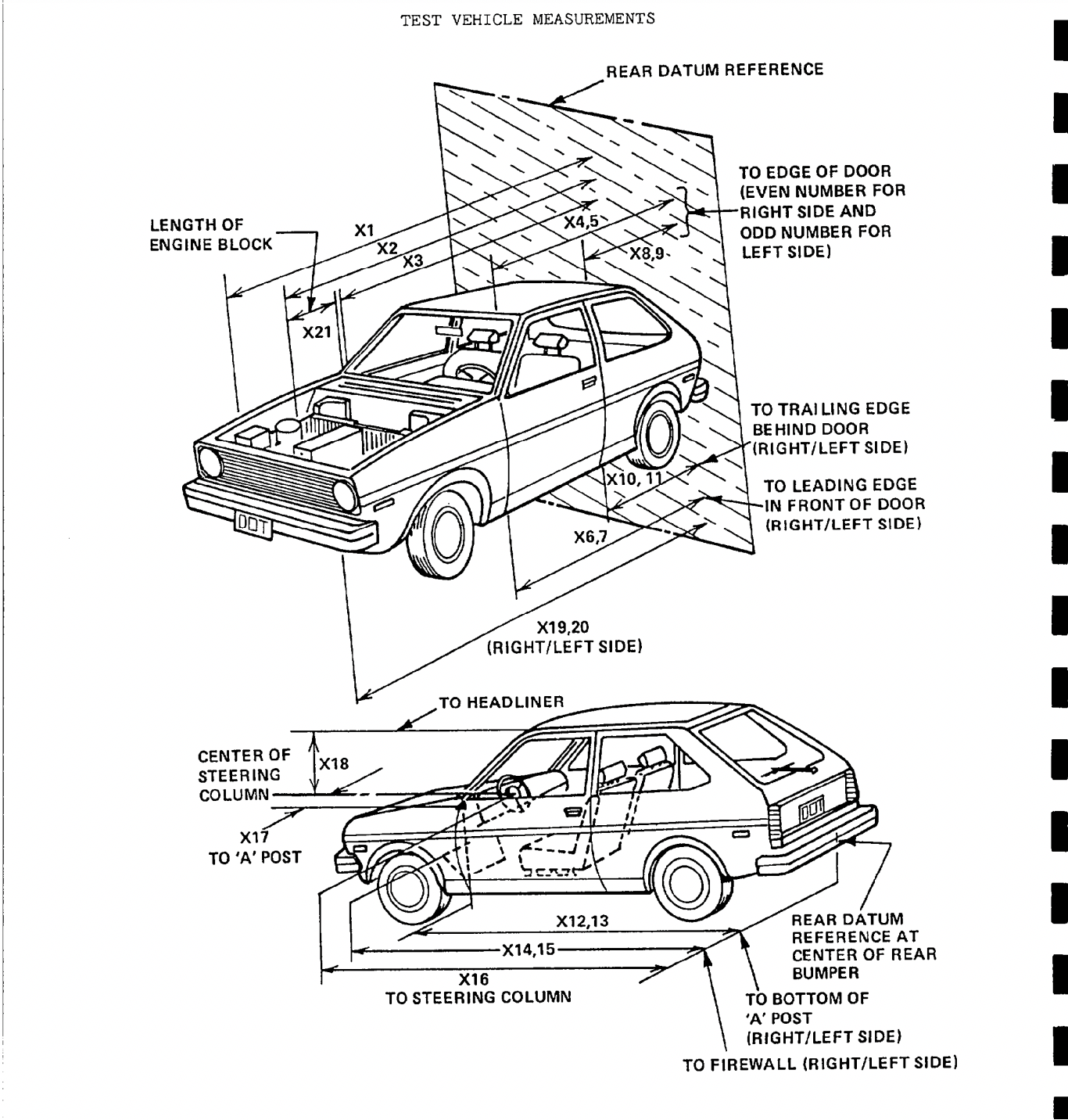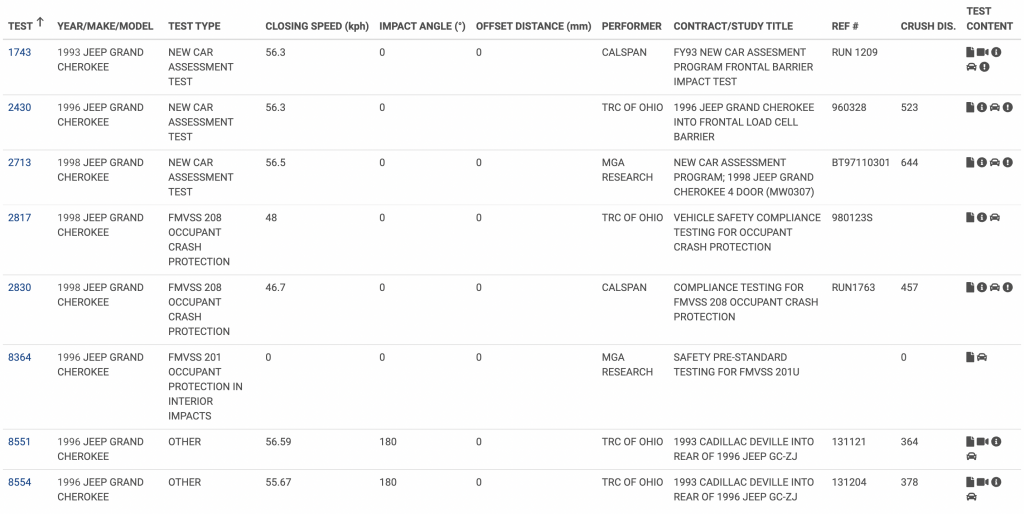I’m currently in the process of building an overlanding vehicle using a 1994 Jeep Grand Cherokee (see below). Key to my build is knowing how much my vehicle weighs. Ideally, I’d just drive my vehicle onto a scale, but the Jeep isn’t mobile, and I’d like to continue planning and getting parts ready for my suspension lift. So how can I estimate my vehicle’s weight? Well, I could just google “1994 Jeep Grand Cherokee curb weight,” but then I’d find numbers all over the place, since the Jeep came with a bunch of different options.
Having the curb weight for a V8 automatic Limited model with leather and a bunch of other options isn’t going to tell me how much my base-model six-cylinder weighs. And while you can easily find car reviews in which a magazine has weighed its test car, those review vehicles are usually well-optioned. This is the beauty of National Highway Traffic Safety Administration’s (NHTSA) crash test database — vehicles that get crash tested are almost always base-models. So, to get information for my stripper-model Jeep, all I have to do is go to nhsta.gov/ratings, type in my vehicle:
Then click search. Then I just scroll down to the technical report:
Here’s a peek at that technical report’s front page:
You Can See How Old Vehicles Were Configured From The Dealership
The great thing about these technical reports is just how detailed they are. For one, right away I’m able to figure out what the stock tire size was on my Jeep (I’ve sent my VIN to Stellantis, current maker of Jeep Grand Cherokees, and learned that their build-sheet system is a bit janky for older cars). As you can see, the base model ZJ Grand Cherokee came from the factory with tiny 215/75R15s. Sure, you could find this in a brochure, but it’s cool to see that vehicles purchased from a dealership (where NHTSA got its car) actually did come with that small tire size, as most of the Munrony labels I’ve seen show a 225mm tire chosen as a dealer option:
This is helpful, as I’ll be installing a set of those little tires as I work to bring my other base-model Grand Cherokee (a 1993) back to bone-stock condition. On the data sheet, you can see that the test machine was a bare-bones base model with just a few options: Cruise control, power steering, air conditioning, and an automatic transmission. This vehicle is outfit exactly like my 1993 and 1994 Jeeps, except it has an automatic. Then there’s this section:
You Can See Weights And Other Dimensions
This section of the crash test document shows the vehicle’s curb weight as NHTSA received it from a dealer: 3,748 pounds. So I can expect my manual version, which is very similarly equipped, to probably weigh roughly around 3,700 pounds, accounting for the difference between an automatic and manual (flywheel and clutch versus torque converter and flex plate, liquid cooling versus air cooling, etc. — more on this assumption later). You can also see in this section the weight distribution: 57 percent of the weight is at the nose while 43 percent is at the rear axle. This information proved useful when our contributor here at The Autopian needed the Tesla Model S’s weight distribution for his story about the physics behind the flying Model S stunt. Also on the data sheet is the vehicle’s track width and overall length, all of which have been very precisely measured:
What I especially love are the extremely random measurements NHTSA needed for its crash test evaluations:
[Editor’s Note: in case you’re curious, I’m pretty sure the default car depicted here is a ’70s-era Ford Fiesta. It looks like a VW Rabbit, especially at the front, but if you look at the lines of the Fiesta especially the sides and rear, I’m pretty sure that’s what the model was. — JT] Turns out that 4.0-liter engine block length is 660 mm, or roughly 26-inches, and that it does not get compressed during a crash (see row towards the bottom). Useless info? Sure!:
The Pictures Are The Real Gold
But the true gold in these crash test technical reports is in the photos. Where else will you find detailed underbody images of brand new, base-model cars? And especially to someone trying to restore their vehicle to factory spec, this is some great stuff. The image above shows what my Jeep ZJ’s underbody should look like as it came from the dealership. Just looking at this, I can see that I’m missing an engine splash guard; I also have a good view of the type of tires my Jeep was equipped with from the factory. This should help me come up with something that has a similar tread pattern, since these original tires are almost certainly no longer for sale.
And how great is this photo of the Jeep’s rear suspension? (Incidentally, I think the ZJ may be the very first 4×4 ever sold en masse in the American market with a five-link rear suspension):
Here, have a look at a brand new 4.0-liter straight six in a Jeep ZJ engine bay:
I wish I had a photo from the other side to show the EXACT routing of the spark plug wires, but alas.
The exterior photos are helpful, too. My 1993 Jeep ZJ came with some hideous aluminum wheels, and though my vehicle’s brochure shows that the stock wheels should have been steel, I don’t know exactly which wheels they should have been, since Jeep offered multiple steelies. Well, it’s clear that the base wheels for 1993 were the six-spokes in the image above. These are basically Jeep Cherokee XJ wheels, but with silver center caps instead of black ones. Not only that, but it appears that Jeep tried dressing up those XJ wheels with something else:
The exterior photos also help me see that my bumpers are supposed to be two-tone.
Though my ZJ has what appears to be a two-tone look on its bumpers, I was never really sure, since the bumpers have faded so much. Finding a base-model ZJ image in a brochure was rather difficult, so that NHTSA image helps as I work to bring this thing close to factory condition:
As you can see above, the wheels are awful, so I’ve snagged some XJ wheels:
Using the crash test images as reference, I also nabbed the right center caps and some chrome trim rings, as well as some 215 75R15 tires:
Plus, I grabbed some 215 75R15 tires (from the junkyard, of course):
I highly recommend that you check out NHTSA’s Crash Test Database, pull up your vehicle, and thumb through some of the reports. There are a lot more tests at that link than you might think, and much more than if you just pulled up the NHTSA website like I showed earlier in this article. I looked up the ZJ-generation (1993 to 1998) Grand Cherokee, and just look at all the reports I can read:
NHTSA’s database includes crash information from various crash test centers — TRC of Ohio, CALSPAN, and even the Insurance Institute for Highway Safety. These reports all include detailed vehicle information and imagery. I recently used these reports to determine the difference in curb weight between a manual Jeep Grand Cherokee and an automatic, using datasheets from two similarly-equipped XJ Cherokees (one with a manual, one auto). There’s a lot of great stuff here, so check it out! Your comment about the plug wire routing had me wondering,have wire jackets gotten a lot better over the years? As a kid I remember moving those around a lot to try to get rid of small misfires from interference but I haven’t had that problem on vehicles with a distributor in years. It’s also possible Dad got the cheapest wires and they were the problem. We were poor and even when he had money he wasn’t thinking long term, just trying to get to work tomorrow. And to think I used to blissfully drive my 2 year old kid around in one of those little death traps. Holy shit. One detail: The “random” measurements aren’t random. If you compare the drawing with the measurements to the pictures, you can see that the measurements are to the target stickers applied to the vehicle before testing. By recording the “before” dimensions, they can then accurately determine how much the vehicle deformed in the crash. Thanks for the deep dive David I also had a heck of a time trying to find a new splash shield for my ZJ as the original one was effectively in tatters. So I just brought home a 94 ZJ laredo with 112k (113K after driving back Chicago from Colorado) and I have been having a hard time finding parts. I have it in my head that I want stay as close to stock as possible since she’s kind of a survivor. Zero rust anywhere and no major mechanical issues other than some tired shocks and coil springs. Truck has had 2 owners since 93 and it has been garaged kept and dealer maintained. Anyways, I was able to find a couple parts catalog pdfs that have really helped. The first is a “1994-1996 OEM Parts Catalog Universal” on justjeeps.com and it literally has everything. I’m still working on decoding the vehicle numbers but it was been great! (I got it in my head that I wanted to upgrade it to the “Up Country” suspension but the parts are impossible to find. Also is the black front grill a stock item? Mine has the same but I remember my parent’s 94 laredo having a chrome grill. The second is from old man emu and it lists stock all the specs on their coil springs along with the OE spring rates. I decided on the OME 2931 in the front and 2940s in the rear along with Bilstein 5100 shocks. I’m looking forward to following your build!























